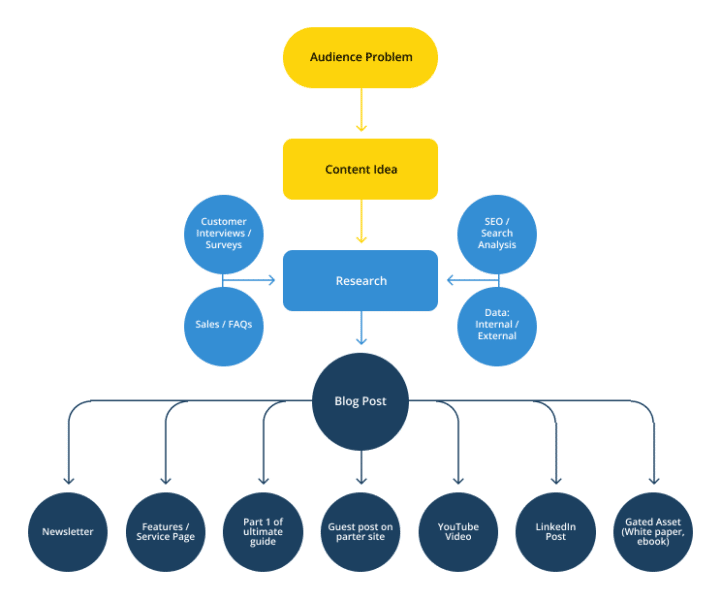Between the roll-out of the helpful content update and the emphasis of E-E-A-T on every query and search result, Google is clear about the significance SEOs should place on good, valuable content in 2023.
Given that, I’d like to break down the approach, process, and resources my team uses to tackle content this year.
I’m not just talking about a content calendar, which is one facet of your content strategy. I’m talking about using your audience understanding and your organization’s branding to build a content system that provides genuine value.
The right approach for valuable content
The emphasis on quality and value in content is good for marketers, even if it shifts a bit of focus away from quantitative metrics like clicks and external links.
Producing good content will rely on a rich understanding of your audience, good fundamental content structures, and solid delivery methods – marketing skills that will always be relevant.
Start with your audience. Who are they? What do they need? What content should you deliver to help them get there?
Approach content like any other product or service:
- Find or understand a need and address it.
- Know the emotions (fear, uncertainty, urgency, etc.) in play.
Here’s an example of a valuable piece of content that’s rewarded with a top spot in the SERP even though the title and query aren’t exactly aligned.

Click into the article, and you’ll see NerdWallet’s helpful, on-brand approach to a knee-jerk question. They offer calm, informed content that gives context around the latest crypto crash and guides readers to consider their full economic picture before making any emotion-driven decisions.
Developing a voice that addresses an understanding of problems is valuable, hard to do, and, most importantly, a competitive edge.
Content that helps advance brand differentiation, as the NerdWallet piece does, makes it much harder for your competition to poach your audience by upping the trust ante.
Building a process to create valuable content
The content strategy path I like to prescribe is as follows:

- Problem aware: Empathize with your audience by articulating their problem in a clear, differentiated way.
- Solution aware: Present your audience with objective, detailed, valuable options for solutions to their problem.
- Brand aware: Develop your brand’s association as a trusted solution provider.
- Product aware: Position your specific product or service as the ideal solution for the reader’s problem.
Following this path will:
- Drive increased discussion, knowledge, and education around the problem.
- Introduce new solutions that audiences hadn’t yet considered.
- Position your brand as something transformative, unique, and revolutionary.
The problem itself will give you an idea for content that you can take into the research stage.
Once your research is conducted, you’ll have what you need to craft content and deploy it in multiple ways.
The flow looks like this:

I’d like to call out a couple of themes here:
- SEO / search analysis is one piece of the research pie. Google wants us to write for our target audience, not for Google. Dig into the qualified and quantified information that helps you achieve that.
- Truly useful content that isn’t written solely for SERP rankings should be highly engaging on any number of channels and in multiple formats. Don’t stop at a blog post, and don’t just rely on Google for eyeballs.
Resources to use in content development
Presumably, you know how to use Google’s keyword research tools and external tools (e.g., Ahrefs or Semrush). I’ll focus on tools that go beyond keywords to help you develop your content priorities.
Qualitative interviews
Surveys are useful and often expensive if you’re trying to reach an audience outside your CRM.
You can get great insights if you can facilitate other ways to engage subject matter experts with the same professional experiences, challenges, and responsibilities as your target audience.
Slack communities, (live or virtual) meet-ups, and memberships in organizations like the AMA or ANA can provide on-the-ground perspectives for your content mapping.
Social media
Not all social media posts are created equal, but understanding your audience includes knowing where your audience likes to engage: Twitter, Reddit, YouTube, TikTok, etc.
Work those platforms to get information on what your audience is talking about in real-time, and you’ll be able to see trends as they emerge.
Google Search Console
GSC can provide excellent insight into the performance of your previous content performance and give you data on what people are doing on your site and previous content. This allows you to see underperforming content and top-performing content.
For the former, consider what might be missing in the content you can address. For the latter, spin-off more content if the theme allows, do internal linking, and build deeper authority on the topic to establish a competitive advantage.
Competitor analysis
Competitor analysis, in this case, doesn't mean just looking for keywords with low competition. It means assessing:
- Where your competitors are leaning in.
- What ground they aren't covering.
- What formats they are or aren't using.
- What angles they might be taking on broader topics that leave room for your unique point of view.
Go into your research looking for opportunities to stand apart rather than just copying everything your competitors are doing.
Moving the needle with helpful content
Taking this approach to content may ultimately change how you view content KPIs.
Instead of clicks and impressions, for instance, you may put yourself in a position to report on leads and opportunities generated and influenced.
Along with burnishing your brand and helping build awareness, valuable content can move the needle at every stage of the buying journey.
Google’s heavy-handed guidance on helpful content might feel uncomfortable if it forces a pivot in your approach, but in the long run, it may just make us all better marketers.
The post How to build a ‘helpful’ content strategy for 2023 appeared first on Search Engine Land.
via Search Engine Land https://ift.tt/GS4d5zv

No comments:
Post a Comment